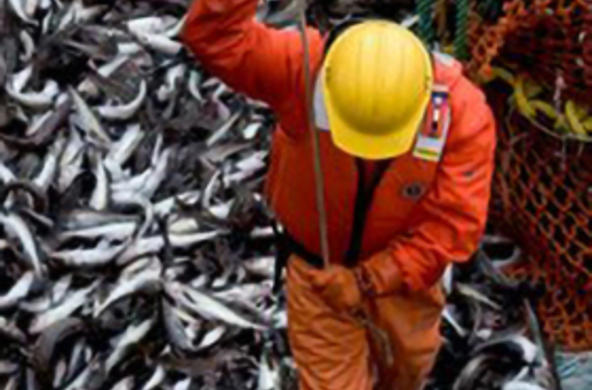Whole-lake experiment shows habitat preferences leave fish vulnerable to overfishing
(Millbrook, NY) Fishery collapses can be difficult to forecast and prevent due to hyperstability, a phenomenon where catch rates remain high even as fish abundance declines. In a recent Canadian Journal of Fisheries and Aquatic Sciences study, researchers conducted a whole-lake experiment to reveal the causes of hyperstability in recreational fisheries. Fish habitat preferences were found to leave them vulnerable to overexploitation.
Chris Solomon, an aquatic ecologist at Cary Institute of Ecosystem Studies, was an author on the paper. He explains, “The few previous studies on hyperstability in recreational fisheries, like those in commercial fisheries, have relied on observational data. By using an experimental approach, we were able to reveal the underlying cause of a problem that has vexed fisheries managers.”
By manipulating the abundance of largemouth bass in a northern Wisconsin lake, Solomon and colleagues undertook the first experimental test of hyperstability. Over the span of three months, the research team changed the abundance of bass in Camp Lake on a weekly basis, from over 350 to only 25 fish. Electrofishing was used to temporarily move animals from the lake’s main basin to an isolated side basin.

Once a week, three anglers fished for two hours in the morning and two hours in the evening, boating along the shore. They targeted the littoral zone, preferred bass habitat, and recorded the location of each fish hooked. When their catch rates were compared to the known abundance of bass in the lake each week, the team documented that angler success remained high until only a few fish remained.
The mechanisms believed to cause hyperstability are habitat aggregation and effort sorting. Habitat aggregation refers to the tendency of fish species to cluster in areas with preferred habitat features like fallen trees or aquatic vegetation. Effort sorting refers to angler skill, with less skilled anglers moving on as fish decline, resulting in high catch rates for the remaining skilled anglers.
Lead author Colin Dassow, a PhD candidate at the University of Notre Dame, explains, “Previous studies have linked hyperstability to effort sorting. By using a fixed set of anglers, we excluded this variable. Habitat aggregation was the driver of hyperstability collapse in Camp Lake. Hyperstability heightens the risk of fishery collapse because anglers don’t get any signal that fish are in trouble until it’s too late.”

Solomon explains, “We found that hyperstability can occur simply because anglers know where fish like to gather, even at times of year when fish are not densely aggregated for spawning. That’s worrisome because most fish species have habitat preferences – suggesting that many recreational fisheries may be susceptible to hyperstability.”
According to the paper’s authors, limiting angler effort is the primary way to protect fish that are vulnerable due to habitat aggregation. This could take the form of shortening the fishing season, reducing harvest limits, or prohibiting fishing when and where fish gather to spawn. These aren’t always popular policies, but they could prove instrumental to conserving fish stocks and quality fishing opportunities.
“Protecting the economic, social, and ecological benefits of healthy fisheries requires closer monitoring,” Dassow notes. “Unfortunately, data reported by anglers is patchy and data collected by researchers and state agencies is too costly to undertake at scale. Both types of data inform our understanding of how the system as a whole is ‘working’, but we don’t have enough of either type.”
Solomon concludes, “It’s important for anglers to understand that what comes out of the water is not always representative of what lies beneath the surface. Even if the fish are biting, this doesn’t mean there are many of them. Anglers, fisheries managers, and other stakeholders must work together to advocate for better monitoring and sensible limits on effort if we want to sustain good fishing opportunities now and in the future.”
Citation
Colin J. Dassow, Alexander J. Ross, Olaf P. Jensen, Greg G. Sass, Brett T. van Poorten, Christopher T. Solomon, Stuart E. Jones. Experimental demonstration of catch hyperstability from habitat aggregation, not effort sorting, in a recreational fishery. Canadian Journal of Fisheries and Aquatic Sciences, 2020, 77:762-769, https://doi.org/10.1139/cjfas-2019-0245
Investigators
Colin Dassow – University of Notre Dame, Biological Sciences; Alexander Ross – Cary Institute of Ecosystem Studies; Olaf Jensen – Rutgers University, Institute of Marine & Coastal Sciences; Greg Sass – Wisconsin Department of Natural Resources, Escanaba Lake Research Station; Brett van Poorten – Ministry of Environment and Climate Change Strategy; Christopher Solomon – Cary Institute of Ecosystem Studies; Stuart Jones – University of Notre Dame, Department of Biological Sciences
Cary Institute of Ecosystem Studies is an independent nonprofit center for environmental research. Since 1983, our scientists have been investigating the complex interactions that govern the natural world and the impacts of climate change on these systems. Our findings lead to more effective management and policy actions and increased environmental literacy. Staff are global experts in the ecology of: cities, disease, forests, and freshwater.






